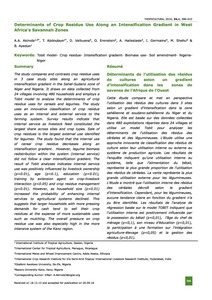| dc.contributor.author | Akinola, Adebayo A. |
| dc.contributor.author | Abdoulaye, Tahirou |
| dc.contributor.author | Valbuena, Diego |
| dc.contributor.author | Erenstein, Olaf |
| dc.contributor.author | Haileslasie, A. |
| dc.contributor.author | Germaine, I. |
| dc.contributor.author | Shehu, M. |
| dc.contributor.author | Ayedun, B. |
| dc.date.accessioned | 2019-12-04T11:04:44Z |
| dc.date.available | 2019-12-04T11:04:44Z |
| dc.date.issued | 2016 |
| dc.identifier.citation | Akinola, A., Abdoulaye, T., Valbuena, D., Erenstein, O., Haileslasie, A., Germaine, I., ... & Ayedun, B. (2015). Determinants of crop residue use along an intensification gradient in West Africa’s savannah zones. Tropicultura, 396-410. |
| dc.identifier.issn | 0771-3312 |
| dc.identifier.uri | https://hdl.handle.net/20.500.12478/1492 |
| dc.description | Open Access Journal |
| dc.description.abstract | The study compares and contrasts crop residue uses in 3 case study sites along an agricultural intensification gradient in the Sahel-Sudano zone of Niger and Nigeria. It draws on data collected from 24 vii/ages involving 480 households and employs a Tobit model to analyse the determinants of crop residue uses for cereals and legumes. The study uses an innovative classification of crop residue uses as an internal and external service to the farming system. Survey results indicate that internal service as livestock feed constituted the largest share across sites and crop types. Sale of crop residues is the largest external use identified for legumes. The study found that the internal use of cereal crop residue decreases along an intensification gradient. However, legume biomass redistribution within the system (internal service) did not follow a clear intensification gradient. The result of Tobit analyses indicates internal service use was positively influenced by livestock ownership (p<O.Ol), age (p<O.l), education (p<O.Ol), training by extension agent on crop-livestock interaction (p<0.05) and crop residue management (p<O.Ol). However, as household size (p<O.Ol) increased the· probability of enhancing internal services to agricultural systems declined. This suggests that larger households with more pressing demands for cash tend to sell their crop residues at the expense of more sustainable uses such as mulching. The overall pressure on crop residue use was also especially high in the more intensive system of the Kano region. Therefore, given the importance of crop residue for livestock feed and soil cover in these fragile savannah system and the high pressure for competing uses of crop residues, there is need to develop and promote potential substitute to ensure sustainability. |
| dc.description.sponsorship | CGIAR Systemwide Livestock Programme |
| dc.format.extent | 396-410 |
| dc.language.iso | en |
| dc.subject | Crop Residue |
| dc.subject | Agricultural Products |
| dc.subject | Tobit Model |
| dc.subject | Biomass Use |
| dc.subject | Soil Amendment |
| dc.subject | Intensification Gradient |
| dc.title | Determinants of crop residue use along an intensification gradient in West Africa's Savannah zones |
| dc.type | Journal Article |
| dc.description.version | Peer Review |
| cg.contributor.crp | Grain Legumes |
| cg.contributor.affiliation | International Institute of Tropical Agriculture |
| cg.contributor.affiliation | International Center for Tropical Agriculture |
| cg.contributor.affiliation | International Maize and Wheat Improvement Center |
| cg.contributor.affiliation | International Crops Research Institute for the Semi-Arid Tropics |
| cg.contributor.affiliation | Obafemi Awolowo University |
| cg.contributor.affiliation | Bayero University |
| cg.coverage.region | Africa |
| cg.coverage.region | West Africa |
| cg.coverage.country | Niger |
| cg.coverage.country | Nigeria |
| cg.identifier.url | http://www.tropicultura.org/text/v34n4/396.pdf |
| cg.isijournal | ISI Journal |
| cg.authorship.types | CGIAR and developing country institute |
| cg.iitasubject | Grain Legumes |
| cg.journal | Tropicultura |
| cg.howpublished | Formally Published |
| cg.accessibilitystatus | Open Access |
| local.dspaceid | 80969 |
| cg.targetaudience | Scientists |

